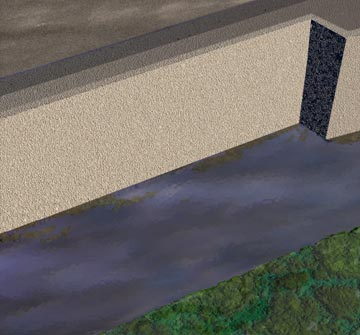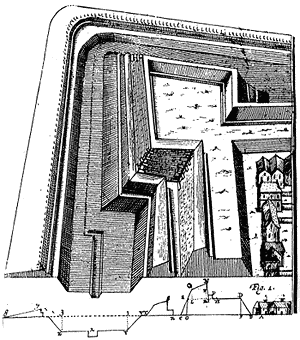Nasty Enhancements to Moat & Ramparts

Note the little notch in the bottom of the moat illustrated
here.
A trench, dubbed a 'cuvette,' could be dug along the ditch bottom. After the ditch
filled to become a moat, the water may still have been shallow enough to
permit attackers to wade across, even in chest-high water.
Unseen to them, though, was that underwater trench. Stepping into
it, they would have stumbled or even gone under. Cuvettes were
sometimes even dug for dry ditches as additional hindrances to
retard attackers' rush to the ramparts.

 To see a fausse-braye of a masonry fort,
click here.
Double-click that link to return to the original image.
To see a fausse-braye of a masonry fort,
click here.
Double-click that link to return to the original image.To slow attackers another way, a fence of closely spaced posts or stakes was sometimes set all around the outside of the fortification. These could be posts in the moat, at the base of the ramparts or set horizontally near the top of the ramparts.
- Posts in moat
- Posts at base of ramparts
- Sharpened stakes set horizontal near the rampart tops (at times termed 'storm poles')
Deep into the siege, gaps may have been opened with artillery in fences like these. But one may surmise those gaps could have been to the defense's advantage by "encouraging" attackers in boats or on foot to go toward the openings, at which the besieged knew to concentrate their cannon and musket fire.
Posts along the ramparts' base were sometimes upgraded with solid, low walls, the fausse-braye, in particular around masonry forts. Providing an additional line of defense, musketeers hunkered down behind this lower position to pick off attackers approaching the edge of the moat or ditch.
A foul touch added to the moat was the presence of outhouses over the still, murky waters. At first sight one would consider this merely a convenience for waste disposal, but it added a psychological deterrence: announcement was made to any attacker that the water they wished to set foot in was sewage.
